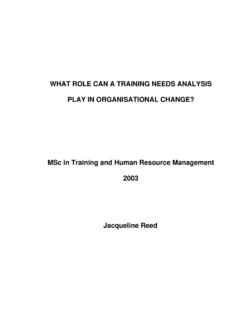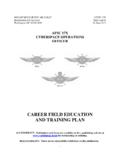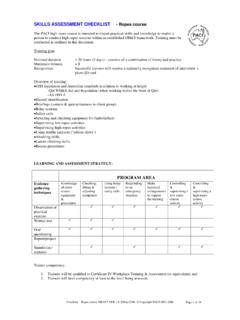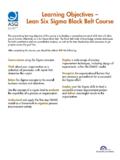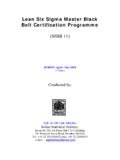Transcription of Function Points Analysis Training Course
1 Page 1 Longstreet Consulting Inc Function Points Analysis Training Course Instructor: David Longstreet Page 2 Table of Contents Introduction _____ 7 Objective of Section:_____ 7 Introduction: _____ 7 Elementary Process: _____ 8 Definition: _____ 8 Benefits and Uses: _____ 9 When Not to Use Function Points _____ 10 Types of Function Point Counts:_____ 10 What about Lines of Code (LOC) _____ 11 Understanding Productivity: _____ 11 Understanding Software Productivity: _____ 12 Questions: _____ 14 Function Point Counting Process _____ 17 Objective of Section:_____ 17 Introduction: _____ 17 Definition: _____ 17 Types of Function Point Counts:_____ 18 High Level Steps: _____ 18 Independence and Dependence: _____ 18 FPA Steps for Files: _____ 20 Questions: _____ 20 Establishing the Boundary _____ 21 Objective of Section:_____ 21 Definition: _____ 21 Identify the Boundary: _____ 21 Standard Documentation: _____ 21 Establishing the Boundary early in the Life cycle: _____ 21 Technology Issues: _____ 22 Tabulating.
2 _____ 22 Questions: _____ 22 Identifying RET s, DET s, FTR s _____ 23 Page 3 FP Online Class Objective of Section:_____ 23 Definition: _____ 23 Rating: _____ 24 Transaction DET s: _____ 24 Record Element Types (RET s): _____ 24 Tips to Identify RET s and DET s early in the life cycle: _____ 24 DET s for GUI_____ 24 DET s For Real Time Systems_____ 26 Navigation _____ 26 Skill Builder: _____ 26 External Inputs _____ 28 Objective of Section:_____ 28 Definition: _____ 28 Rating: _____ 28 Counting Tips: _____ 28 Examples: _____ 29 Data Elements: _____ 29 File Types Referenced (FTR s): _____ 29 Uniqueness: _____ 30 Understanding Enhancement Function Points : _____ 30 Technology Issues: _____ 30 Standard Documentation: _____ 31 Tips to Identify External Inputs early in the life cycle:_____ 31 Typical Vocabulary: _____ 32 Skill Builder: _____ 32 External Outputs _____ 34 Objective of Section:_____ 34 Definition: _____ 34 Rating: _____ 34 Counting Tips: _____ 35 Terminology: _____ 35 Examples: _____ 35 Data Elements.
3 _____ 35 Page 4 File Types Referenced (FTR): _____ 36 Uniqueness: _____ 36 Understanding Enhancement Function Points : _____ 36 Technology Issues: _____ 37 Standard Documentation: _____ 37 Tips to Identify External Outputs early in the life cycle: _____ 37 Typical Vocabulary: _____ 37 Special Issues and Concerns: _____ 38 Skill Builder: _____ 39 External Inquiries _____ 43 Objective of Section:_____ 43 Definition: _____ 43 Rating: _____ 43 Examples: _____ 44 Terminology: _____ 44 Data Elements: _____ 44 File Type Referenced (FTR s): _____ 45 Uniqueness: _____ 45 Understanding Enhancement Function Points : _____ 45 Technology Issues: _____ 46 Standard Documentation: _____ 46 Tips to Identify EQ s early in the life cycle: _____ 47 Typical Vocabulary: _____ 47 Special Issues and Concerns: _____ 47 Skill Builder: _____ 49 Transaction Review _____ 52 Objective of Section.
4 _____ 52 Multiple Languages _____ 52 Display of Graphical Images or Icons_____ 53 Messages _____ 54 Complex Control Inputs _____ 55 Hyperlinks on WebPages _____ 55 Internal Logical Files _____ 56 Objective of Section:_____ 56 Page 5 FP Online Class Definition: _____ 56 Rating: _____ 56 Counting Tips: _____ 56 Examples: _____ 57 Record Element Types: _____ 57 Data Element Types: _____ 58 Technology Issues: _____ 58 Standard Documentation: _____ 58 Tips to Identify ILF s early in the life cycle: _____ 58 Other comments: _____ 58 Skill Builder: _____ 59 External Interface Files_____ 62 Objective of Section:_____ 62 Definition: _____ 62 Rating: _____ 62 Counting Tips: _____ 63 Examples: _____ 63 Technology Issues: _____ 63 Standard Documentation: _____ 63 Tips to Identify EIF s early in the life cycle: _____ 64 General System Characteristics_____ 65 Objective of Section:_____ 65 Definition: _____ 65 Rating: _____ 65 Standard Documentation: _____ 65 Rating GSC s early in the life cycle: _____ 65 Tabulating: _____ 66 GSC s at a Glance.
5 _____ 66 Considerations for GUI Applications _____ 67 Detail GSC s:_____ 68 Skill Builder: _____ 79 General System Characteristics Notes Page _____ 80 History and IFPUG _____ 81 Page 6 Objective of Section:_____ 81 Brief History: _____ 81 Growth and Acceptance of Function Point Analysis _____ 81 More Information about IFPUG: _____ 81 Calculating Adjusted Function Point_____ 83 Objective of Section:_____ 83 Understanding the Equations:_____ 83 Definition: _____ 84 Unadjusted Function Point:_____ 84 Development Project Function Point Calculation: _____ 84 Application Function Point Count (Baseline): _____ 85 Enhancement Project Function Point Calculation: _____ 85 Application After Enhancement Project: _____ 86 Skill Builder: _____ 88 Case Studies _____ 89 Objective of Section.
6 _____ 89 Collection Letter _____ 91 Control Inputs_____ 92 Graphical Information _____ 93 Graphs Part II_____ 94 The Weather Application_____ 95 Adding A New Customer _____ 97 Enhanced Weather Application _____ 100 BikeWare _____ 101 Pizza Screen Design _____ 103 _____ 105 Control Information _____ 108 Page 7 Longstreet Consulting Inc INTRODUCTION Objective of Section: Introduce the basic concepts of Function Point Analysis and to introduce and reinforce unit cost estimating. The exercises at the end of the section help the student demonstrate they have gained the basic knowledge required.
7 Introduction: Systems continue to grow in size and complexity, becoming increasingly difficult to understand. As improvements in coding tools allow software developers to produce larger amounts of software to meet ever-expanding user requirements, a method to understand and communicate size must be used. A structured technique of problem solving, Function point Analysis is a method to break systems into smaller components, so they can be better understood and analyzed. This book describes Function point Analysis and industry trends using Function Points . Human beings solve problems by breaking them into smaller, understandable pieces.
8 Problems that may initially appear to be difficult are found to be simple when dissected into their components, or classes. When the objects to be classified are the contents of software systems, a set of definitions and rules, or a scheme of classification, must be used to place these objects into their appropriate categories. Function point Analysis is one such technique: FPA is a method to break systems into smaller components, so they can be better understood and analyzed. It also provides a structured technique for problem solving. Function Point Analysis is a structured method to perform functional decomposition of a software application.
9 Function Points are a unit measure for software much like an hour is to measuring time, miles are to measuring distance or Celsius is to measuring temperature. Function Points are interval measures much like other measures such as kilometers, Fahrenheit, hours, so on and so forth. Function Points measure software by quantifying its functionality provided to the user based primarily on the logical design. Frequently the term end user or user is used without specifying what is meant. In this case, the user is a sophisticated user. Someone that would understand the system from a functional perspective --- more than likely someone that would provide requirements or does acceptance testing.
10 There are a variety of different methods used to count Function point, but this book is based upon those rules developed by the Alan Albrecht and later revised by the International Function Point User Group (IFPUG). The IFPUG rules have much to be desired, so this book attempts to fill in gaps not defined by IFPUG. 1 Chapter 1 Page 8 What is on the surface? The image to the right represents the tip of an iceberg. The real issue is not the tip, but what is under the surface of the water and can not be seen. The same is true when you design a software application.


